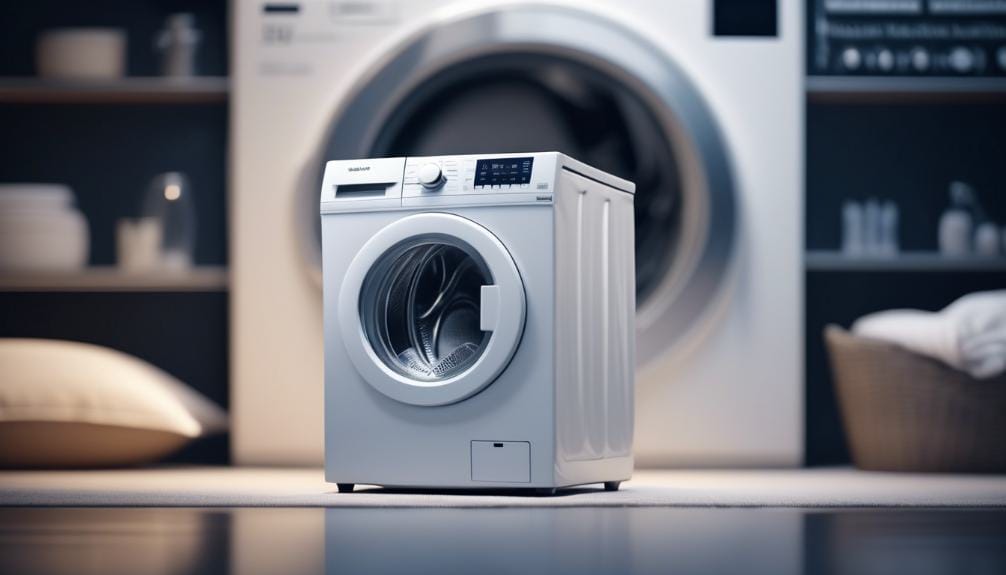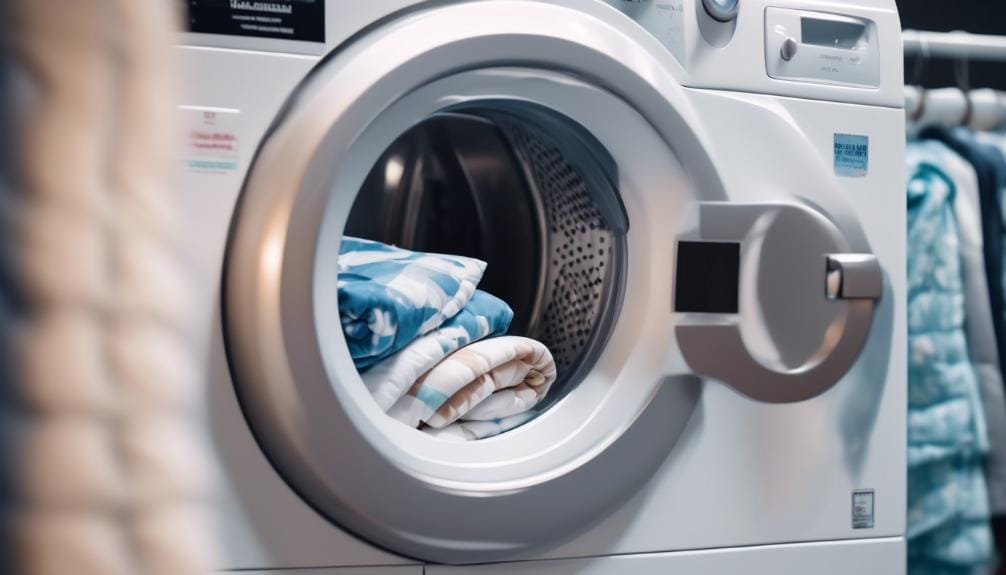What Wash to Put Duvet On: Laundry Settings Guide
Are you tired of guessing the right laundry settings for your duvet, only to end up with unexpected results? Understanding the proper wash settings for your duvet is essential to maintaining its quality and prolonging its lifespan.
From deciphering the care symbols to selecting the appropriate temperature and wash cycle, there are crucial steps to consider. But fear not, as we’re about to unveil the ultimate guide to help you master the art of laundering your duvet with confidence and ease.
So, if you’re ready to elevate your laundry game and ensure your duvet stays fresh and clean, let’s dive into the expert tips and tricks that will revolutionize your approach to duvet care.
Key Takeaways
- Decipher the care symbols on the duvet’s label to determine the appropriate washing cycle.
- Consider the specific filling material (down, feather, or synthetic) for different cleaning methods.
- Refer to the care label instructions for the appropriate water temperature.
- Use a gentle water cycle for delicate materials and opt for a low heat setting in the dryer.
Understanding Duvet Wash Symbols

To understand the proper care for your duvet, you need to decipher the wash symbols on the care label with attention to detail and accuracy. The care label provides essential information about the appropriate washing cycle for your duvet. Look for symbols indicating machine wash, dry clean, or hand wash. Additionally, take note of the recommended water temperature and the type of detergent to use.
When washing your duvet, it’s crucial to consider the specific filling material, whether it’s down, feather, or synthetic, as each requires different cleaning methods. Make sure to follow the gentle cycle and other instructions from the care label to ensure proper cleaning.
Once the washing is complete, the care label symbols will guide you on the suitable drying method, whether it’s machine drying, air drying, or professional dry cleaning.
Washing Duvet at the Right Temperature

Consider the duvet’s care label instructions to determine the appropriate water temperature for washing, ensuring the preservation of its quality and integrity.
When washing a duvet, especially one with natural materials or synthetic fibers, using warm water is often recommended. However, always refer to the care instructions as some duvets may require washing in cold water to prevent damage to the filling and fabric.
Following the manufacturer’s guidelines for the right water temperature is crucial to maintain the duvet’s quality. Using the wrong water temperature can lead to shrinking, clumping, or damaging the duvet’s filling and fabric.
Washing at the right temperature ensures effective cleaning while preserving the duvet’s integrity. Once washed, air dry the duvet or duvet cover if possible to maintain its shape and prevent any potential damage from the heat of the dryer.
Selecting the Appropriate Wash Setting

When washing your duvet, always check the care label for the recommended wash settings and detergent to ensure proper care and maintenance. Use a gentle water cycle and select the appropriate water temperature based on the material—cold for delicate fabrics and warm for stains. When drying your duvet, opt for a low heat setting in the dryer and fluff it regularly. For some duvets, air-drying in a well-ventilated area until completely dry may be recommended. It’s essential to follow the recommended frequency guidelines for washing to maintain its freshness and cleanliness. Here’s a quick reference for selecting the appropriate wash setting:
| Wash Setting | Description |
|---|---|
| Gentle Water Cycle | Use for delicate materials |
| Low Heat Dryer | Dryer setting to use for duvet |
| Air-Drying | Consider when applicable for thorough drying |
Drying Duvet Correctly

Ensure your duvet is dried in a large-capacity dryer on low heat to prevent clumping and ensure even drying, as recommended after selecting the appropriate wash setting.
Add dryer balls or clean tennis balls to help fluff the duvet while it dries.
Stop the drying process periodically to fluff and redistribute the filling for even drying.
It’s crucial to make sure the duvet is completely dry before storing or using it again to prevent mold or mildew growth.
If a dryer isn’t available or if weather permits, consider air-drying the duvet in a well-ventilated area.
Always follow the instructions on the duvet’s label for the best drying method.
Tips for Laundering Different Duvet Types

To effectively launder different types of duvets, it’s important to understand the specific care requirements based on the material of the duvet.
Before washing, pre-treat any stains using a suitable stain remover and check for rips or tears.
When washing, use a gentle, warm water cycle with half the recommended amount of gentle laundry detergent. Consider adding tennis balls in clean socks for extra agitation.
After washing, check for soap residue, fluff the duvet periodically during drying, and ensure it feels light and evenly distributed when dry.
Clean your duvet insert every two or three months to eliminate dirt, pet dander, dust, grime, sweat, and odors. Spot clean as necessary and follow the care instructions for your specific duvet type, avoiding high heat and harsh chemicals.
Frequently Asked Questions
What Is Duvet Setting on Washing Machine?
To wash a duvet in a washing machine, use a gentle, warm water cycle with an extra rinse and spin cycle. Add tennis balls in clean socks for agitation. Dry thoroughly, and use wool dryer balls for quicker drying.
How Do You Wash a Down Quilt in the Washing Machine?
To wash a down quilt in the washing machine, use a gentle, cold water cycle and mild detergent. Then, dry it thoroughly in a large-capacity dryer on low heat, adding dryer balls to fluff it up. Always check the care label first.
What Is the Best Wash Cycle for a Duvet Cover?
For a duvet cover, use a gentle cycle with cold or warm water and mild detergent. Avoid bleach and harsh chemicals. Dry on low heat or air-dry to prevent damage. Washing every 1-3 months keeps it fresh.
What Is the Meaning of Duvet in Washing Machine?
When washing a duvet in a machine, it means cleaning the duvet insert and cover. Follow the label’s washing instructions, pre-treat stains, and use a large-capacity washer. For drying, choose low heat for synthetics and air or low heat with tennis balls for natural materials.
Conclusion
Now that you understand the duvet wash symbols and the appropriate wash settings, you can confidently launder your duvet with ease.
Remember to pre-treat any stains, use a gentle, warm water cycle, and ensure the duvet is fully dry before putting it back on the bed.
Following these tips will help you keep your duvet clean and fresh for a good night’s sleep.
